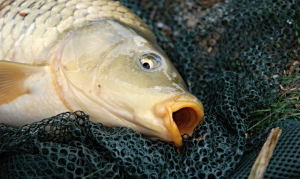Australia's War on Carp Explained

Herpes?
No thankyou.
How about carp?
Also a hard pass.
Biological control?
It sounds scary. It must be a bad idea. It stirs images of Contagion in my mind.
How do these things fit together?
Yep, you guessed it. Scientists have suggested using herpesvirus as a biocontrol to eradicate invasive carp populations in Australian waterways. Yes, herpes. But no, not the type that humans can catch.
Carp cause immense damage to freshwater environments all over Australia. The fish have destructive feeding habits, stirring up mud and sediment, damaging water plants and negatively affecting native species by changing their habitat and competing for food.
Eradicating a species like carp can be very costly and complicated. Unfortunately we can’t rely on over-fishing to decimate this fish population, as carp are far from an Aussie delicacy. Small measures are already in place to control carp but these measures are yet to make a dent in population numbers. If you catch a carp when fishing, for example, you are legally obliged to kill it rather than release it back into the waterways.
The carp herpesvirus, CyHW-3, appeared in Israel in 1998 and was so contagious that it soon spread throughout Europe, Asia, and North America. Signs of the disease appear one or two weeks after infection then the fish dies within a day. This means the viral pathogen would be extremely effective and require minimal human intervention after introduction.
Fifteen million dollars of funding was granted for the National Carp Control Plan in 2016, with the intention of releasing the virus into the carp population in 2018. Extensive research has been undertaken at CSIRO to ensure that this particular strain of herpesvirus will not affect humans or any other species.

The national coordinator of the National Carp Control Plan, Mr Matt Barwick, said that the date and location of release will be the focus of careful research over the next two years.
“We know the virus works best within a water temperature range of around 16 to 28 degrees Celsius, so it will be important that any possible release takes place at the right time to optimise results.”
The flow of rivers and movement of carp play an important role too, and are closely considered in the plan to ensure optimal results.
“When floodwaters inundate floodplain habitats during warmer months they often aggregate in high numbers to access spawning areas. We know that fish-to-fish contact is an important means for transmission of the virus, so there is opportunity to use this aggregating behavior for targeted release and clean-up efforts.”
So why hasn’t the virus been introduced yet?
Carp were introduced in the 1800s for European aquaculture but escaped from farm dams near Mildura in the 1960s, spreading throughout the Murray Darling Basin. Carp now make up 80% of biomass, the total of all plants and animals, in the Murray River alone. It’s not surprising that many people have been concerned about disposal of the dead fish. It has been suggested that the large fish kills, estimated to be millions of tonnes of carp, can be used as fertiliser or pet food.
Additonally, the thought of consuming waterborne herpes is just gross and the social stigma around the introduction of the virus has caused plenty of backlash. It does sound like a barbaric idea but it is actually a huge step in the right direction.



Be the first to comment!